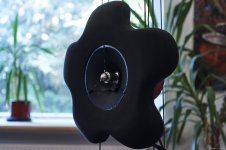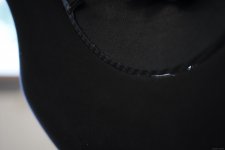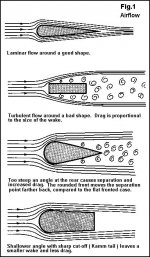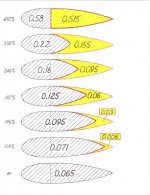the truncated pyramid looks better than the hemisphere too
Not quite.
Like a car the waveform flows over and around the enclosure. the trailing back on the teardrop subtley helps over the already nice sphere. The difference between the sphere and the hemiSphere indicates how the back half affects things.
dave
Last edited:
Here is another interesting option. No felt here, but interesting building material and shape to deal with baffle diffraction. Can't find where Mattes gave more build details, but an interesting thread indeed.Well now I’m interested. Would you mind sharing your thoughts on the ideal baffle for full range?
I’ve edited the thread name slightly
EVA foam for performance speaker enclosures
Well now I’m interested. Would you mind sharing your thoughts on the ideal baffle for full range?
~~~~~~~~~~~~~~~~~~~~~~~~
IMHO a wide band, that has any issues, can not be improved with a *superior baffle** design.
I just cut any old size port, place a thin ,,say 2 inches, of pink glass fiber attic insulation along back wall, up roor and down on bottom of cabinet,,, glue the tops of insul to top of cabinet,,and you're done. Sounds super.
Its a 50 liter cabinet.
30 inches high, 10 wide X 10 Deep, Sounds super. best speaker ;ve ever heard.
DavidLouis VX8.
DavidLouis VX8, Perfection - YouTube
~~~~~~~~~~~~~~~~~~~~~~~~
IMHO a wide band, that has any issues, can not be improved with a *superior baffle** design.
I just cut any old size port, place a thin ,,say 2 inches, of pink glass fiber attic insulation along back wall, up roor and down on bottom of cabinet,,, glue the tops of insul to top of cabinet,,and you're done. Sounds super.
Its a 50 liter cabinet.
30 inches high, 10 wide X 10 Deep, Sounds super. best speaker ;ve ever heard.
DavidLouis VX8.
DavidLouis VX8, Perfection - YouTube
I'm not sure you've quite understood what is being discussed on this thread.
A drive unit's free air / anechoic frequency response on an IEC compliant test setup is what it is. However, the practical frequency response is immediately altered away from that the moment you put the driver on a regular loudspeaker baffle. This is caused by two main factors: step loss (the transition from effective 2pi to 4pi radiation space), and edge diffraction. It is largely edge-diffraction we are talking about on this thread, and the various methods that can be employed to reduce its effects. This is a consequence of the baffle design (its size and shape), and while in many cases it can look much worse on a graph than it sounds in practice, when outright performance is the goal some consideration is given to reducing these effects. This doesn't 'improve the drive unit'. Careful baffle design or baffle damping are simply methods to reduce the damage caused by diffraction at the baffle edges.
A drive unit's free air / anechoic frequency response on an IEC compliant test setup is what it is. However, the practical frequency response is immediately altered away from that the moment you put the driver on a regular loudspeaker baffle. This is caused by two main factors: step loss (the transition from effective 2pi to 4pi radiation space), and edge diffraction. It is largely edge-diffraction we are talking about on this thread, and the various methods that can be employed to reduce its effects. This is a consequence of the baffle design (its size and shape), and while in many cases it can look much worse on a graph than it sounds in practice, when outright performance is the goal some consideration is given to reducing these effects. This doesn't 'improve the drive unit'. Careful baffle design or baffle damping are simply methods to reduce the damage caused by diffraction at the baffle edges.
Last edited:
Here is another interesting option. No felt here, but interesting building material and shape to deal with baffle diffraction. Can't find where Mattes gave more build details, but an interesting thread indeed.
EVA foam for performance speaker enclosures
Hi,
Some have been asking about details here and there, and I gave some details here and there. Some have required a lot of information by PM and have, after receipt of same, never responded again.
The aim of my baffles was to reduce the negative influences of a baffle (as it has been correctly explained by Dr. Lindgren) as far as possible, by choosing shape and material accordingly, while paying special attention to the region where the cone mets the baffle. This should, in my opinion, be a smooth transition without steps, edges etc.
If I will ever make an improved version, I will take even greater care about this area with the aim to have an uninterrupted smooth shape from voicecoil to baffle edge.
All the best
Mattes
Attachments
I was thinking of one or two layers (more effective?) of wool felt as a covering on the baffle. Reaching from the driver edge to the box edges
Better to do like NHT did way back when and add strips of fairly dense open cell foam to quell baffle eigenmodes, though they could be felt also: NHT 3.3 loudspeaker | Stereophile.com
Absolutely, streamline hydrodynamics shows that when you get beyond a critical threshold, the form & length of the run tends to take equally or greater significance for resistivity than that of the entrance (foremost part of a body up to its largest sectional area). The question of course becomes where the speaker is positioned -if you've got flush-mount to the front wall, we need to shift our baseline a bit. 
Last edited:
Yes I was interested to see that the tail holds so much importance.
My pair of Sota11r are mainly bound for desk duties. I'm not sure how rear boundary changes the design constraints though.
I was interested to read that you use a modified Viotti One as your desk speakers. might be too much for my space though
My pair of Sota11r are mainly bound for desk duties. I'm not sure how rear boundary changes the design constraints though.
I was interested to read that you use a modified Viotti One as your desk speakers. might be too much for my space though
Strictly speaking, they're either side of the desk -I'd struggle to stick them on the desktop and have room to write too. 
My Viottis are actually pre-production units; they were my test mules, so they're looking a bit tired now, but they still work fine. From an acoustic POV, the main difference is the filter, which I redesigned to suit my own preferences.
My Viottis are actually pre-production units; they were my test mules, so they're looking a bit tired now, but they still work fine. From an acoustic POV, the main difference is the filter, which I redesigned to suit my own preferences.
Patrick bateman said if an enclosure were a tall column, diffraction looks like a sphere.
Well, very high aspect ratio.
Well now I’m interested. Would you mind sharing your thoughts on the ideal baffle for full range?
OK.
- Home
- Loudspeakers
- Full Range
- Full Range Felt



